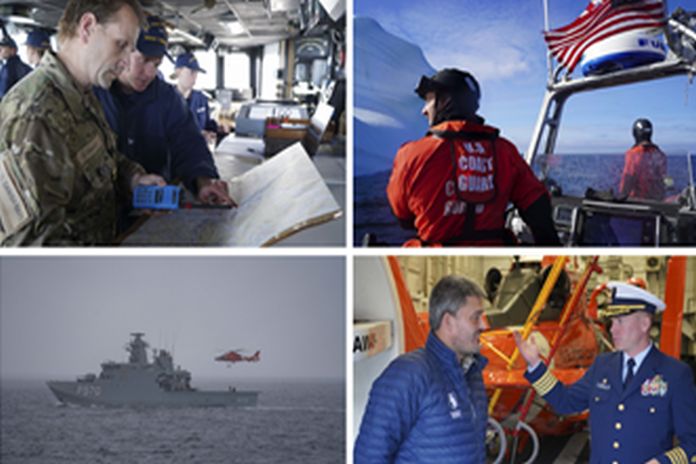MAINE, USA — US Coast Guard Cutter Campbell (WMEC 909) returned to homeport Tuesday, following a two-month deployment supporting joint Arctic operations off Greenland’s western coast.
Campbell’s crew contributed to joint exercises, research and development efforts, and critical diplomatic engagements while covering more than 11,500 miles (10,000 nautical miles).
“I am very proud of the efforts and adaptability of every one of Campbell’s crew who demonstrated the ability to operate and execute our mission aboard one of the finest Famous-class cutters in the fleet, said Captain. Thomas Crane, commanding officer of Campbell. “Their dedication to duty and commitment to the Coast Guard helps to affirm the United States as an Arctic nation. It is also a credit to the name Campbell and our five predecessors. In addition to notable narcotics seizures and being the command ship for the 1996 TWA 800 recovery, we are now the first 270-foot medium endurance cutter to earn the Arctic Service Medal.”
Campbell sailed with additional support, including an embarked MH-65 Dolphin helicopter and aviation detachment consisting of two pilots and four aircrew, including a rescue swimmer. In all, eight shipriders augmented the 100 person crew during the patrol, assisting in operations, providing health services, and documenting the journey.
“I am humbled by the opportunity to be a part of this historic mission and am glad our crew’s experiences will be shared with family, friends, and future generations,” said Crane. “Going to sea is challenging and requires personal sacrifices both from our crew and loved ones left onshore. Still, the camaraderie, teamwork, and pride of our crew are the reasons I go to sea. Campbell is a great ship with a great crew able to execute missions of strategic national significance amid a global pandemic.”
In early August, Campbell departed Kittery for Nuuk, Greenland, to participate in joint search and rescue exercise operations with French and Royal Danish naval assets.
“This effort strengthens international partnerships and provides a foundation for standard operations in the rapidly developing Arctic maritime environment,” said vice admiral. Steven Poulin, commander US Coast Guard Atlantic Area. “As interest and maritime traffic in the area increases, the importance of the US Coast Guard’s interoperability with allied partners becomes more critical to ensuring we protect national and shared security interests. Exercising our unique blend of polar operational capability, regulatory authority, and international leadership across the full spectrum of maritime governance is vital to the future of the Arctic.”
The Kingdom of Denmark defense force’s Joint Arctic Command Search and Rescue Exercise ARGUS included 13 simulated coastal and open-ocean scenarios, evaluating processes and interoperability through communications testing, vessel towing evolutions, rescue boat training, and helicopter sea and land operations.
Campbell’s crew employed its embarked Dolphin crew extensively, conducting joint evolutions and professional maritime exchanges with the Royal Danish navy vessels HDMS Knud Rasmussen and HDMS Triton. They also applied NATO procedures to test interoperability with regard to ship controlled approaches, launch, recovery, and hoisting. The crews conducted joint US-Danish surface and air operations in Eternity Fjord and Disko Bay, Greenland, the most active iceberg-producing area globally.
Professional exchanges with HDMS Knud Rasmussen provide an opportunity to gain valuable navigation knowledge along Greenland’s coastline and fjord system. Campbell patrolled the Labrador Sea waters, Davis Strait, and the Baffin Bay, navigating Greenland’s largely uncharted western coast, including ice-laden bays and fjords, often using rudimentary sounding data as electronic charts are unavailable for the area. Throughout the patrol, Campbell safely completed over 200 helicopter evolutions, including 16 joint evolutions with the Danish navy.
In support of the National Oceanic Atmospheric Association, International Ice Patrol, and Coast Guard Research and Development Center, Campbell’s crew conducted testing of specialized equipment and resources in the Arctic environment. They deployed oceanographic research buoys across Baffin Bay, the Labrador Sea, and the North Atlantic to measure ocean currents and wave heights that influence iceberg drift and deterioration.
“This valuable data can provide a better understanding of the lifecycle of icebergs that impact transatlantic shipping lanes,” said Mike Hicks, of the International Ice Patrol.
IIP also analyzed 317 synthetic aperture radar and multi-spectral images from satellites to monitor iceberg danger during Campbell’s operations. This effort, led by IIP’s Lt. Don Rudnickas, denotes the first time in history, novel, scalable, and tailored iceberg warning products were produced with only satellite observations, depicting iceberg danger at higher granularity using oceanographic models to provide forecasted iceberg positions.
“This input significantly shapes the future of iceberg warning products in the North Atlantic and expands the capability of IIP to provide direct, tailorable support to vessels operating independently; an ability beyond the IIP’s statutory mission, but one that is likely to become highly desired with increasing Arctic operations,” said Hicks.
Matthew Lees was the RDC Demonstrations Liaison and coordinated technology evaluations for the patrol. These included:
- An Iridium Certus Terminal which helped provide internet access for the crew to maintain communications with Atlantic Area;
- Two different enhanced night vision goggle devices improved law enforcement and flight operations, even integrated into ship’s display screens;
- A Long Range Acoustic Device, also known as an LRAD, was evaluated for enhanced communications with vessels at longer distances;
- A handheld Glare Helios Green Laser tested for similar stand-off hailing capabilities.
The crew also learned essential lessons using a FiFish Remotely Operated Vehicle in cold weather to conduct underwater inspections.
“As cruise ship and commercial vessel traffic increases through the Northwest Passage, Campbell’s recent patrol highlights our commitment to ensuring the safety and security of US citizens,” said Rear Admiral. Thomas Allan, commander Coast Guard 1st District. “This was also a fantastic demonstration of how we work with our partners as we seek to respect sovereignty, maximize the use of our assets, and promote environmental stewardship.”
They facilitated multiple key diplomatic engagement opportunities throughout their Arctic deployment. Campbell’s crew welcomed aboard Danish Major General Kim Joergensen, commander of Joint Arctic Command, and Sung Choi, US consul in Nuuk. Campbell’s diplomatic work was underscored by the opportunity to host Greenland’s premier, Kim Kielsen, signifying the importance of international cooperation for the region.
“Campbell’s efforts continue the United States’ strong relationship with Greenland, furthering a positive foundation for how the Coast Guard will interact and operate in the region,” said Poulin. “As an Arctic nation, cooperation and understanding of the dynamic and ever-changing Arctic operating environment is vital. The US Coast Guard is the primary polar and Arctic surface operator of the US military. The Coast Guard is committed to working collaboratively with like-minded partners through exercises like ARGUS strengthening global maritime security, regional stability, and economic prosperity.”








